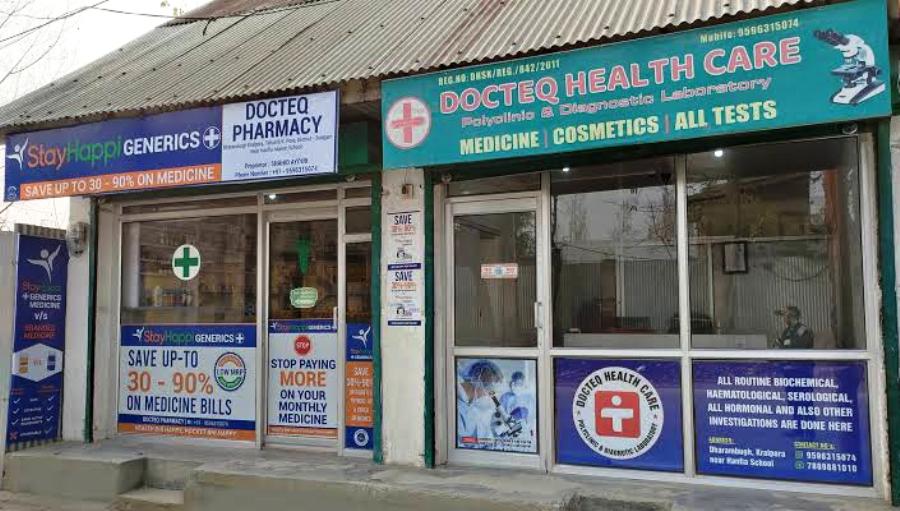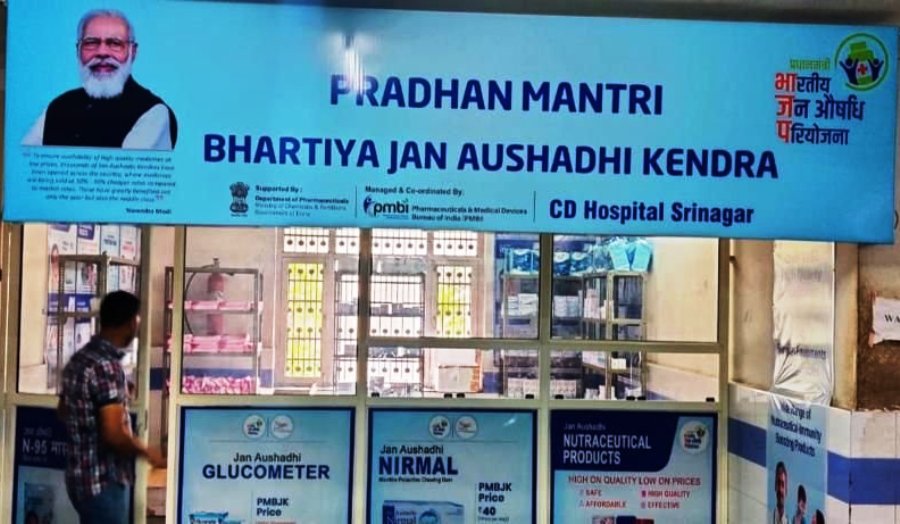With government focus on cheap medicines and doctors apparently supporting branded preparations, an ‘unwell’Kashmir, an otherwise huge pharmaceutical market, is gradually making generic medicines mainstream, reports Hashim Zakir

Yawar, 22, suffering from depression and schizophrenia, experienced an anxious wait during his routine check-up at a government-run hospital in Srinagar. Despite the long queue that tested his patience, Yawar remained eager to receive treatment and overcome his illness. After hours of waiting, it was finally his turn for the check-up. Upon its completion, the doctor advised him to purchase the prescribed medications and return them for physical verification of it.
In India, the usage and prescription of generic medicines face resistance from both the public and doctors, disregarding the efforts made by the National Medical Commission (NMC) and the Central Government to promote their usage.
The Department of Pharmaceuticals, in collaboration with the Central Pharma Public Sector, launched the Pradhan Mantri Bhartiya Jan Aushadhi Pariyojana campaign in November 2008. Its aim was to ensure the availability of high-quality generic medicines at affordable prices for all. According to the Pharmaceuticals and Medical Devices Bureau of India (PMBI), as of August 6, 2021, there are 8,012 functional Jan Aushadi Kendras (generic medicine centres) across the country. The product range includes 1,616 drugs and 250 surgical items.
“I bought drugs from a Jan Aushadhi Kendra and showed them to my doctor, who was not pleased to see ‘cheap medicines’,” Yawar said. “Despite the doctor’s instructions, I decided to use the same medicines and found them to be equally effective. Since then, I always buy medicines from Jan Aushadhi Kendra, significantly reducing my expenses by Rs 2,500.”
Resistance
An amendment in Clause 1.5 of the Indian Medical Council states, “Every physician should prescribe drugs with generic names legibly and preferably in capital letters, ensuring rational prescription and use of drugs.” To this, there is a lot of resistance.
Patients insist that doctors disregard these orders and, at times, “force” the consumption of branded medicines.

“It was a huge benefit. For a middle-class person like me, saving more than 50 per cent of my medical bill in a month was literally a net earning,” Kousar Bashir, 24, who is fighting Atopic Dermatitis, respiratory ailment, and depression, said. “However, when I took the Jan Aushadhi Kendra medicines, the symptoms of my disease remained the same, and at times even worsened. Since then, I have stopped taking generic medicines.”
The book Bottle of Lies: Ranbaxy and the Dark Side of Indian Pharma by Katherine Eban explore the topic of generic medicines. Drawing from over 20,000 FDA documents and interviews with more than 240 individuals, the book conveys a clear message: “Just because I’m a hypochondriac, I have great faith in medicine. Whenever I pop a pill, I do so in full confidence it will work. To my horror, I now discover that’s terribly mistaken in the case of many generic drugs and, particularly, those made in India. A large number are actually ineffective and a few even harmful.”
Reflecting on the affordability of generic medicines, an individual, who wishes to stay anonymous, remarked: “It’s true that generic medicines are affordable. Jan Aushadhi was a great step by the government. However, the effectiveness of these medicines is questionable. Not only did they fail to work in my case, but I also have examples of others facing similar experiences.”
The debate continues. It exists at an academic level, the medical practitioner level and the patient level. There are people supportive of its consumption and against its use. ” If the government genuinely wants to assist patients and middle-class individuals, they should propose innovative ideas to ensure the effectiveness of these medicines,” expressed Kousar.
Trust Deficit
“Branded medicines are developed by pharmaceutical companies and are protected by patents. Generic medicines, on the other hand, are copies of brand-name medicines that have the same dosage, intended use, effects, side effects, route of administration, risks, safety, and strength as the original drug,” explained Prof Mohammed Ishaq Geer, an expert from the Department of Pharmaceutical Sciences at the University of Kashmir. “A generic medicine works in the same way and provides the same clinical benefit as its brand-name version.”

In order to make generic medicines compulsory and readily available, the Government of India introduced the Generic Drug Promotion Policy nationwide and established Jan Aushadhi stores for selling generic medicines. “These medicines are manufactured by Public Sector Undertakings (PSUs) and undergo rigorous checks for quality, safety, and effectiveness before being released to the market and sold through Jan AushadhiKendras,” Geer added.
The 2020 policy aims to encourage the widespread adoption of generic drugs in the country. It includes mandatory prescription of generic medicines in all government hospitals and clinics, financial incentives for pharmaceutical companies producing and selling generic medicines, and awareness campaigns to educate the public about the advantages of using generic medicines.
“If gold is priced lower, it can feel fake,” argues Geer. “People perceive generics as fake and substandard, resulting in a significant trust issue. They believe that inexpensive medicines may not possess the same quality. Doctors are hesitant to prescribe generics because they haven’t extensively tested them on patients, leading to a lack of trust. This needs large-scale awareness campaigns.”
Scene on Ground
Kashmir is a huge market for pharmacies. Given the scale of morbidity and the sickness of body and mind, Kashmir consumes nearly Rs 1000 crore of medicines a year. There has always been a desperation to have retail outlets that can sell medicines at a slightly low cost given the fact that most of the medicines, mostly lifesaving drugs, have huge margins.
That is the reason why people are consuming a lot of medicines being marketed through the twin systems of Jan Aushadhi Kendra and the Affordable Medicines and Reliable Implants for Treatment Affordable Medicines and Reliable Implants for Treatment (AMRIT) pharmacy network. Jan Aushadhi Kendra’s are operating under the aegis of the Ministry of Chemicals and Fertilizers and AMRIT pharmacies operating under the aegis of the Ministry of Health and Family Welfare are owned by the Government of India PSU, HLL Healthcare.
“Approximately 32,000 patients are visiting 227 Kendras every day in Jammu and Kashmir,” Lt Governor Manoj Sinha said on March 5, 2023. “We are planning to have 75 Kendras in every district.”
“We launched our operations in Jammu and Kashmir in 2010,” Rifat Nazir, the Project Coordinator for Jan Aushadhi Kendra said. “In 2023, we are No 5 across India, doing better business in comparison to some of the biggest states in India.” The number of Kendras has gone up from 21 in 2018 to 227 in March 2023. It includes 109 drug stores, which were launched in the fiscal ending March 2023. “This year, wed area opening 75 retail outlets in the private sector,” Rifat said. Most of these pharmacies operate from the hospital premises and include 137 stores spread across Kashmir.
The turnover has gone up as the people consume Jan Aushadhi’s nearly 2000 medicines and surgical items. In 2018-19, the overall sales across Jammu and Kashmir were Rs 4.79 crore, which jumped to Rs 12.79 crore in 2019-20. “In 2020-21, we recorded sales of Rs 14.50 crore that improved to Rs 22.52 crore in 2021-22,” Rifat said. “In 2022-23, the turnover crossed Rs 43 crore. In the last two months only, we recorded a turnover of Rs 8.50 crore.”
As far as the dozen-odd AMRIT pharmacies are concerned, their basket comprises more than 6000 drugs, implants, surgical disposables, branded drugs and other consumables which are sold at an average discount of 60 per cent.
“As on September 15, 2022, about 8, 45,817 lakh patients have benefitted from AMRIT pharmacies,” an official spokesman said, after a meeting. “The value of drugs dispensed at MRP is Rs19560.37 lakh and the patients have benefitted with a savings of Rs 10269.44 lakh.”















